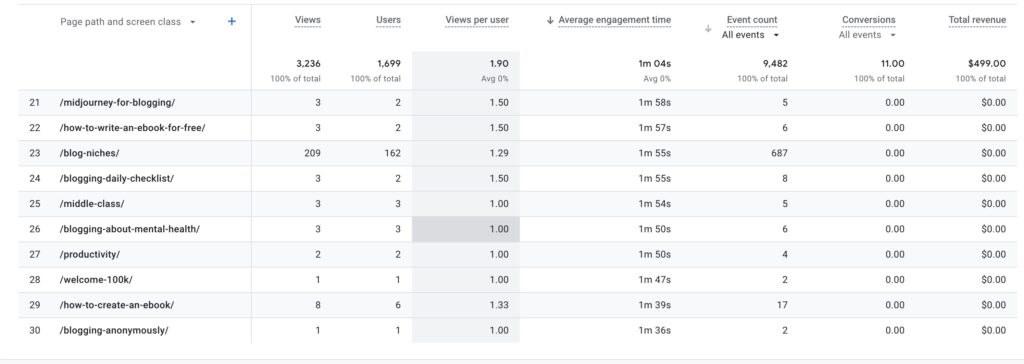I’m an analytics junkie.
I love to jump into Google Analytics and sort things in different ways because I end up seeing numbers jump out at me that I wouldn’t normally notice.
So today I was poking around and I don’t remember what lead me here, but I sorted some things and came to this screen:

Can you guess what popped out at me?
687 under “Event count” for the post /blog-niches.
And so I started down the rabbit hole of what does “Event count” mean in Google Analytics, is it important and what do I do about it?
What Is Event Count in Google Analytics?
I hate when I go to research something and the answer I get back is something like:
An “Event count” is the number of events that happened in a particular time span or page.
Gee, thanks I couldn’t have figured that out from just reading the words.
Basically, an Event count is a sum of certain things a person can do when they are on your site.
Here’s an analogy that might help.
Let’s imagine you have a toy box at home. This toy box is like your website, and your toys are like the different things people can do on your website, like clicking a button or watching a video.
Now, let’s say you really like counting how many times you play with each toy. Every time you play with a toy, you make a little tally mark on a piece of paper. At the end of the day, you can look at your paper and see which toys were the most popular based on how many tally marks each one has.

In Google Analytics, an “Event” is like playing with a toy. Each time someone does something on your website (like clicking a button), it’s like they’re playing with a toy on your website. And the “Event Count” is like your tally marks on the paper. It tells you how many times people played with that “toy” (or did that thing on your website).
So, if a lot of people are clicking the same button on your website, your Event Count for that button will be really high, just like if you played with your favorite toy many times, it would have a lot of tally marks. This helps you understand what people like to do on your website, kind of like how you know which toys are your favorites by how often you play with them.
These are some of the events that GA4 collects as a default:
- first_visit: Captured when a user first visits your site.
- session_start: Recorded at the beginning of each user session.
- page_view: Triggered when a user views a page on your site.
- user_engagement: Measures the time a user spends actively engaged with your site during a session.
- scroll: Triggered when a user scrolls to the bottom of a page. This can be useful for understanding if users are engaging with your full content.
- click: Captured when a user clicks a link that leads them outside of your site. It’s useful for outbound link tracking.
- file_download: Triggered when a user downloads a file from your site.
- video_start, video_progress, video_complete: These events are related to video interaction, capturing when a user starts a video, reaches certain milestones while watching it, and when they complete it.
- view_search_results: Occurs when a user views search results on your site, which is especially useful if your site has a search function.
You can also set up additional events specific to your needs.
Now, what caught my eye was how HIGH the number of events seemed for that particular post on blog niches.
It stood out from all of the posts around it, but what does that “Event count” actually mean?
Interpreting Event Count Data in Google Analytics
Let’s first figure out what constitutes a high Event count. Here’s the image I shared earlier:

687 stands out when you look at just Event counts. However…
You need to compare that number to Users. Obviously, if a page isn’t getting a lot of users to it, then it cannot have a lot of events.
So, if we look at our numbers specifically for the blog niches post, we’re getting on average 4.12 events per user.
What exactly does that mean? Is it good? Is it bad?
Let’s take a look.

This screenshot shows details about the events for that post about blog niches.
You can see that each user has an average of 4 events attached to them. They are getting at least one point toward that Event count score by:
- Viewing the page (page_view) – This event is triggered every time a user views a page on your website. It’s the digital equivalent of someone walking into a room and looking around. It tells you that someone has landed on a page, but it doesn’t give much insight into what they do while they’re there.
- Starting a session (session_start) -This event marks the beginning of a user’s session on your site. Think of it as someone walking into your store. It starts when a user first arrives and ends after a period of inactivity or when they leave the site. It’s useful for understanding how many distinct visits your site gets. If this page were NOT the first page a user came to today, GA would not register a session start event.
- First time visitor: (first_visit) This event is recorded the first time a user visits your site. It’s like noting the first time someone ever walks into your store. This is crucial for understanding how many new visitors you’re attracting. If the person is not a first time visitor, they don’t get this Event added to the count.
- Engaging with the content: (user_engagement) This event measures the time a user spends actively engaged with your site during a session. It’s a measure of not just presence, but interaction and interest. We’ll talk more about this in the next section.
So that means, if a new person comes to your site, they are probably getting at least 3 points added to that “Event count” just because they arrived there. We’re going to call those “gimmes”. Because, it’s a sports thing that fits here perfectly, so we’re calling them that. They don’t have to actually DO anything and you are immediately at a 1:3 user to event count ratio.
It’s like getting your name right on the SAT. It’s a gimme.
So, for a post that is showing 174 users and 708 events, it’s a smidge over 4 events per visitor. That means we’re usually getting the three “gimme” event points plus at least one other point. In this case it’s the user_engagement point.
Now, if we were getting 3 events per visitor and they were just the three “gimme” event points (page_view, session_start and first_visit), then there’s a problem that needs to be solved.
We would need to see how we can that user_engagement event point as a starting point.
Which means we would need to know what IS user_engagement in GA4.
What Counts as User Engagement in GA4?
There are three things that can trigger a “user_engagement” point in GA4:
- The user spends 10 seconds or more on the page
- The user views multiple pages
- The user has a conversion event (this is a specific type of event that you create and designate as being crucial to your business goals)
If we weren’t getting the user engagement point in GA4, then the first thing that I would look at to rectify that is what the heck is going on to have people leave before spending 10 seconds on the site?
That’s a big deal problem. If I were trying to answer this for a client, the first thing I would look at is what the immediate user experience is when someone arrives at the site.
I’d be asking these questions:
- Is this easy to read? (legible font that is big enough to read without squinting? With my old eyes?)
- Do I have to scroll before I get to the content?
- Are there a million ads?
- Are there a million pop ups?
These are all things that might make people leave before those 10 seconds are up and therefore not register as “user_engagement”.
Now, this one might hurt a little, but, if none of the above seem to be the culprit, then, well, you have to take a hard look at your content. Is it interesting enough to get people to stick around for longer than 10 seconds?
But, that’s a topic for another post.
After looking at the site experience, I would look at the roadmap I am laying out in my content and on each page.
Am I linking to other relevant content within the site? Does my header make it easy for people to look for other things they might be interested in after they go through the post they landed on? Basically, am I making it EASY for someone to explore the site?
Conversion events are different than time spent and multiple page views because they are something you have to set up yourself, so we won’t dive into those here.
How This Applies to SEO
The big question is that if you’re trying to rank well with SEO then should you care about this metric and the answer is yes. The reason why is because the more events that happen on page, the more Google feels the person is engaged with the content.
And they want to send people to engaged content because they believe it’s quality.
So don’t dismiss event count because you don’t think it applies to your site. It most certainly does.
So Now What?
You should have a good idea of what Event count means in Google analytics at this point.
Time to put that knowledge to use. Go poke around in GA4 and see how your engagement rate is. Are you only getting the three gimmes? What can you do to improve that?
